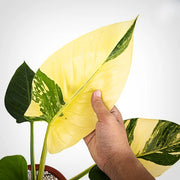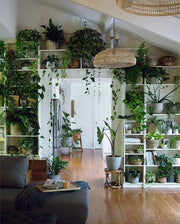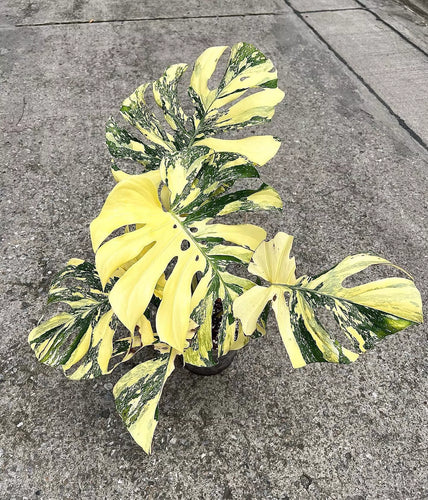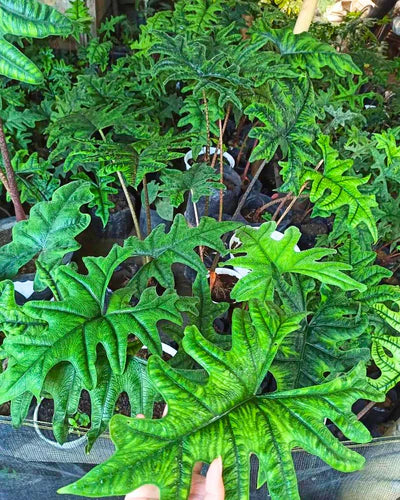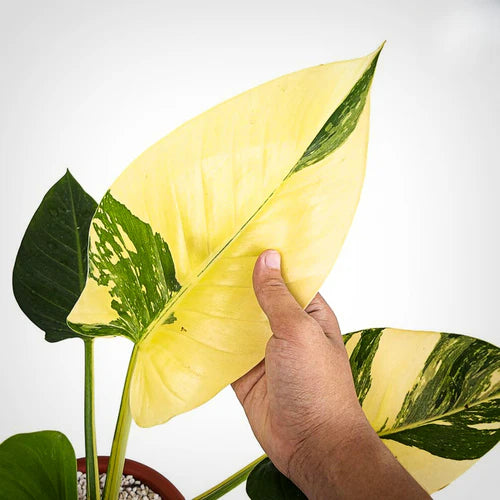How to Increase Humidity for Houseplants
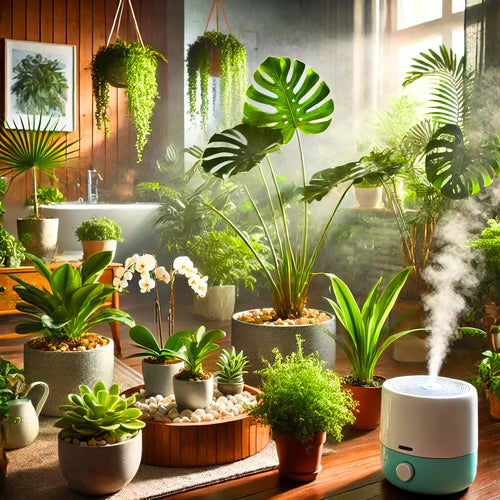
Houseplants bring a touch of nature into our homes, but understanding how to increase humidity for houseplants is crucial for keeping them healthy. While they are generally easy to care for, they have specific needs - one of the most critical being humidity. In this guide, we'll explore the importance of maintaining the right humidity levels and provide you with effective methods to increase humidity indoors.
In this article, we'll dive deep into the importance of humidity for houseplants, the ideal levels, and the most effective ways to increase humidity indoors. We'll also address common questions like whether misting is effective and how high humidity levels can impact your plants.
Table of Contents
- The Role of Humidity in Plant Growth
- What is a Good Humidity Level for Indoor Plants?
- How to Increase Humidity for Plants
- What Humidity is Too High for Plants?
- Is 100% Humidity Bad for Plants?
- Do Houseplants Like High Humidity?
- Do Houseplants Increase Humidity?
- Does Misting Help with Humidity?
- How Often Should I Mist My Indoor Plants?
- Mimicking the Natural Environment of Your Plants

The Role of Humidity in Plant Growth
Humidity plays a vital role in plant growth, impacting everything from water absorption to nutrient uptake. When the air around a plant has high humidity, it reduces the rate of transpiration (the process where plants lose water through their leaves). This means the plant can retain more moisture, which is especially crucial for species that thrive in tropical climates.
In contrast, low humidity levels can cause the plant to lose water faster than it can absorb it, leading to issues like brown leaf tips, wilting, and stunted growth. Ensuring the right humidity level is essential for keeping your plants healthy and vibrant.
Benefits of Humidity for Houseplants Beyond Growth
While humidity is crucial for plant growth, it also impacts other aspects of a plant's health. High humidity helps prevent pest infestations, as many pests, such as spider mites, thrive in dry conditions. Additionally, adequate humidity can improve a plant’s ability to absorb nutrients from the soil, leading to healthier foliage and more vibrant blooms. Plants like ferns and orchids, which are native to humid environments, also tend to produce better flowers when humidity levels are kept high.
What is a Good Humidity Level for Indoor Plants?
Humidity, or how much moisture is in the air, is very important for keeping houseplants healthy. Different types of plants need different amounts of humidity to grow well.
Choosing the Right Plants for Your Home’s Humidity Levels
When selecting houseplants, it’s important to consider the natural humidity levels in your home. For homes with lower humidity, plants like snake plants, succulents, and cacti are ideal because they thrive in drier conditions. On the other hand, if your home naturally maintains higher humidity, or if you’re willing to take steps to increase it, you can opt for tropical plants like ferns, calatheas, and philodendrons. Understanding the specific needs of your plants can help you create an environment where they will thrive.
Regular Houseplants: The Mayo Clinic says that the best humidity level in your home is between 30% and 50%. This range is comfortable for most people and is also good for many common houseplants like snake plants, pothos, and aglaonema. These plants are pretty easy to take care of and can grow well in this humidity. However, if the air in your home gets too dry, like in the winter, even these plants might need a little more humidity to stay healthy.
Tropical Plants: Tropical plants, like ferns, orchids, and monstera, come from very humid places like rainforests. These plants need more humidity to grow well, usually between 60% and 80%. In their natural homes, the air is always moist, which helps them stay healthy and green. If they don’t get enough humidity, their leaves might start to curl, turn brown at the edges, or they might not grow as well.
To help tropical plants get the humidity they need, you can use a humidifier, group them together, or put them in rooms that are already humid, like the bathroom or kitchen.

How to Increase Humidity for Plants
If your home tends to be dry, especially during the winter, it's important to take steps to raise the humidity around your plants. Dry air can cause plants to lose moisture too quickly, which can make them unhealthy. Here are some effective strategies to help increase humidity for your plants:
1. Use a Humidifier
A humidifier is one of the most reliable ways to boost humidity in your home. By releasing a steady stream of moisture into the air, a humidifier can help maintain consistent humidity levels around your plants. This is especially important for tropical plants, which thrive in environments with higher humidity.
2. Create a Pebble Tray
A pebble tray is an easy way to increase humidity around your plants. To make one, fill a shallow tray with pebbles and add water until it just covers the base of the stones or leca balls. Then, place your plant pots on top of the pebbles. As the water evaporates, it adds moisture to the air around the plants, helping them stay hydrated.
3. Group Plants Together
Grouping plants together can create a mini-climate where humidity levels are naturally higher. Plants release moisture into the air through a process called transpiration. When they’re placed close together, the humidity around them increases, benefiting all the plants in the group. Watering these plants regularly will further enhance this effect.
4. Place Plants in Humid Areas
Another simple way to boost humidity is to move your plants to areas of your home that are already humid, such as the kitchen or bathroom. These rooms tend to have higher humidity levels due to activities like cooking and showering, making them ideal spots for plants that love moisture.
5. Use a Greenhouse or IKEA Cabinet
For those who are serious about maintaining high humidity levels, consider using a small indoor greenhouse or an IKEA cabinet. These can be customized to create a controlled environment with the perfect balance of humidity, airflow and temperature, ensuring that your plants thrive.
What Humidity is Too High for Plants?
While some plants thrive in high humidity, levels above 80% can be problematic for many houseplants. Excessively high humidity can encourage mold and mildew growth, as well as attract pests like fungus gnats. Additionally, it can cause the leaves to become overly saturated, leading to rot and other diseases.
Is 100% Humidity Bad for Plants?
A humidity level of 100% is rarely suitable for indoor plants, except for some specific tropical species. In such high humidity, the air is fully saturated with moisture, which can lead to a lack of oxygen exchange in the soil and on the plant's surfaces. This environment is ripe for fungal growth and can severely harm most houseplants.

Do Houseplants Like High Humidity?
Many houseplants, especially tropical ones, do appreciate high humidity levels. Plants such as Ferns, Philodendrons, and Calatheas will often flourish when the humidity is kept above 60%. However, even these plants need some air circulation to prevent mold and mildew.
The Role of Air Circulation in Humid Environments
While increasing humidity is essential for many houseplants, it’s equally important to ensure good air circulation. Without proper airflow, high humidity can create an environment that fosters mold, mildew, and bacterial growth. To avoid this, make sure to place your plants in a space with adequate air movement. You can use a small fan to keep the air circulating, especially in enclosed spaces like greenhouses or plant cabinets. This balance of humidity and airflow will help maintain a healthy environment for your plants.
Do Houseplants Increase Humidity?
Yes, houseplants can indeed increase the humidity in your home. As part of their natural processes—photosynthesis and respiration—plants release moisture vapor into the air. This can slightly raise the humidity levels in your home, especially if you have a large number of plants or group them together.
Grouping your plants can create a microenvironment where the humidity is higher, which is particularly beneficial after watering them.
Does Misting Help with Humidity?
Misting houseplants is a common method people use to boost humidity, but its effects are often short-lived. When you mist a plant, it temporarily increases the moisture on the leaves, which can help them stay hydrated for a brief period. However, this moisture evaporates quickly, usually within 15 to 30 minutes, and does not significantly change the overall humidity level in the room.
For plants that love humidity, misting should be done in addition to other methods like using a humidifier or placing them in a humid environment.
How Often Should I Mist My Indoor Plants?
While some experts suggest frequent misting as a way to increase humidity for plants, it's important to understand its limitations. According to an article from The Los Angeles Times, misting can temporarily raise the humidity around your plants, but the benefits are short-lived.
The fine droplets of water only remain on the leaves for about 15 to 30 minutes, during which time they may provide some moisture. However, unless you are able to mist your plants multiple times a day, this method alone will not provide the sustained humidity levels necessary for plants that thrive in more humid environments. For these plants, relying solely on misting is insufficient to maintain their health over the long term.
Mimicking the Natural Environment of Your Plants
To keep your plants truly happy, it's crucial to replicate the conditions of their natural environment as closely as possible. This means considering not just humidity, but also light, soil, and overall care routines.
For example, a tropical plant that naturally grows in the rainforests of Indonesia will need a similar environment to thrive in your home. This includes high humidity, indirect light, and soil that mimics the nutrient-rich, well-draining substrate found in its native habitat.
Grouping these plants together, providing them with ample moisture, and placing them in a spot where they can get the right amount of light are all key to mimicking their natural environment.
Using Natural Humidity Indicators
Certain plants can serve as natural indicators of the humidity levels in your home. For example, if you notice the leaves of your ferns or calatheas curling or developing brown edges, it’s a sign that the air might be too dry. On the other hand, overly wet or mushy leaves could indicate that humidity is too high. Observing these changes in your plants can help you adjust your indoor environment accordingly to maintain the right balance of humidity.
Incorporating Humidity into Your Overall Plant Care Routine
Finally, consider how humidity fits into your broader plant care routine. Along with watering, feeding, and providing light, maintaining proper humidity should be a regular part of how you care for your houseplants. For instance, when you water your plants, take a moment to check the humidity levels and adjust them as needed. Integrating humidity management into your routine ensures that your plants receive consistent care, leading to healthier and more robust growth.
Understanding and managing humidity levels is essential for the health and well-being of your houseplants. By using the methods outlined in this guide, you can create the perfect indoor environment where your plants can thrive.
For those who are looking for low-maintenance plants that don’t require high humidity, consider this guide to easy-care plants. These options can add greenery to your home without the need for constant humidity management.
Top FAQs on How to Increase Humidity for Houseplants and Prevent Common Issues
Browning leaf edges are a common issue that often indicates environmental stress, particularly related to humidity. When the air around your plant is too dry, it can cause the edges of the leaves to lose moisture more quickly than the plant can replace it. This results in the leaf tips turning brown and crispy. Other possible causes include over-fertilization, which can lead to a buildup of salts in the soil, and inconsistent watering, where the plant is either too dry or too wet at different times.
To prevent browning edges, maintain consistent humidity levels, especially for tropical plants, by using a humidifier, misting, or grouping plants together to create a more humid microenvironment.
Can Low Humidity Cause Pests or Diseases in My Plants?
Yes, low humidity can contribute to pest infestations and diseases in your plants. Dry conditions are favorable for certain pests, such as spider mites, which thrive in low-humidity environments. These pests can weaken your plants, making them more susceptible to diseases. Additionally, low humidity can cause the plant to become stressed, leading to weakened defenses and increasing the likelihood of fungal infections like powdery mildew, which can exploit the plant's compromised state.
To mitigate these risks, it’s essential to maintain adequate humidity levels around your plants, particularly during dry seasons.
Is It Necessary to Mist Plants Every Day?
Misting plants daily is not necessary and often not sufficient to maintain the required humidity levels for most houseplants. While misting can temporarily raise the humidity around a plant, the effects are short-lived, typically lasting only 15 to 30 minutes. For plants that require high humidity, such as tropical species, misting alone won’t provide the sustained moisture they need. Instead, consider using a humidifier or placing plants on a pebble tray to create a more consistent and controlled environment.
For most plants, misting can be done less frequently, and should be supplemented with other humidity-boosting methods.
How Do I Increase Humidity During the Winter Months?
Winter can be particularly challenging for maintaining humidity levels due to the drying effects of indoor heating. To increase humidity during the winter months, you can use several strategies:
- Use a Humidifier: This is the most effective way to add moisture to the air, providing a steady and consistent increase in humidity.
- Pebble Trays: Place your plant pots on trays filled with water and pebbles. As the water evaporates, it raises the humidity around your plants.
- Group Plants Together: This creates a microenvironment where humidity levels are naturally higher due to the collective transpiration of the plants.
- Move Plants to Humid Areas: Bathrooms and kitchens tend to have higher humidity levels, making them ideal spots for humidity-loving plants during winter.
Should I Group Plants Together to Increase Humidity?
Yes, grouping plants together is an effective way to increase humidity around them. When plants are placed close to each other, they create a microclimate where the moisture released through transpiration helps to raise the humidity levels in that area. This method is especially useful for tropical plants that thrive in high-humidity environments. However, while grouping can help, it may not be sufficient on its own if the overall air in your home is very dry. Combining this method with a humidifier or pebble trays can provide better results.
What Are Some Low-Humidity Tolerant Plants?
If your home has low humidity and you prefer not to take extra steps to increase it, consider growing plants that naturally thrive in drier conditions. Some popular low-humidity tolerant plants include:
- Snake Plant (Sansevieria trifasciata)
- Aloe Vera (need more direct sunlight)
- Zebra Plant (Haworthia)
- Spider Plant (Chlorophytum comosum)
- Cacti and Succulents (need more direct sunlight)
These plants have adaptations that allow them to conserve water and thrive in environments with lower humidity, making them ideal for less humid homes.
Should I Place My Plants in the Bathroom or Kitchen for Higher Humidity?
Placing your plants in a bathroom or kitchen can significantly increase the humidity they experience, as these rooms typically have higher moisture levels due to activities like showering and cooking. This is especially beneficial for humidity-loving plants such as ferns, orchids, and calatheas. However, ensure these rooms have adequate light, as some bathrooms or kitchens may be too dark for certain plants. If light is an issue, consider using grow lights to supplement the natural light.
Join the Conversation!
We hope this guide has helped you understand how to increase humidity for your houseplants and tackle common issues like browning leaves and low humidity pests. If you found these tips helpful, please share this article with your fellow plant lovers! Have more questions or want to share your own plant care experiences? Drop a comment below—we’d love to hear from you. Don’t forget to follow us on social media for more expert tips and to join our growing community of houseplant enthusiasts!

